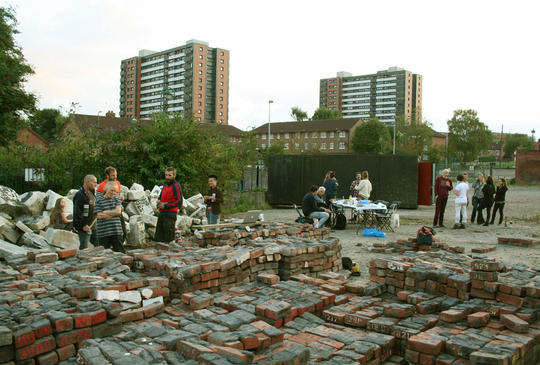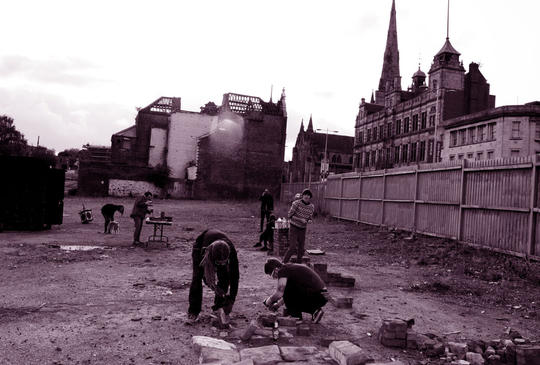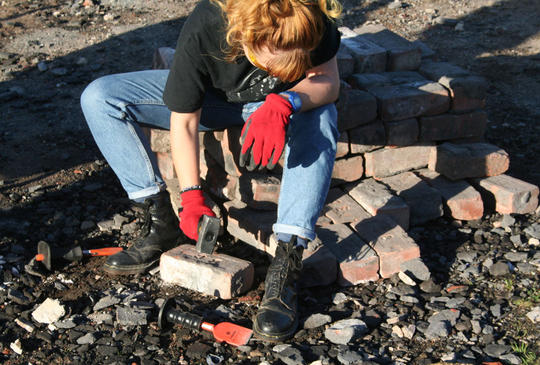
The Wall Needs Your Help This Weekend
“The Wall is an artwork and a proposition – a monument created by community action formed from the regeneration of Salford – It is to move a wall” (http://thewallmustberebuilt.org/)
You don’t need to come from Manchester or Salford to make a difference to a place. Where you come from is less important that the roots or foundations you put down. Take Jen Wu, for instance, and her inspirational project, The Wall.
Moving to Manchester from London in 2012 after carrying out a three month residency at the Chinese Arts Centre in Manchester, Jen was inspired by the legacy of the Hacienda and the creative spirit of a place like Greater Manchester. She found this spirit articulated in the iconic Islington Mill, itself located in the Ordsall ward in Salford.

Image courtesy of Liam Howard.
The Wall is a project about – a wall. But it is so much more than that. Acknowledging that the world is becoming more virtual, Jen nonetheless wanted to connect with the materiality of the social and cultural spaces in the city in an ‘anti-capitalist’ gesture: “as private and corporate interests increasingly divide us and determine our shared space, on this patch of Salford another possibility is taking shape…it has the potential to be a site where people can once again come together – to retain the legacy of a collectively built past and together create a monument for posterity and the future” [1].
"As private and corporate interests increasingly divide us and determine our shared space, on this patch of Salford another possibility is taking shape"
In the midst of the regeneration of the Chapel Street area, the Wall seeks to reclaim the east brick wall and stone façade of the 1920’s Old Bank Theatre, which was originally built as the Royal Liver Friendly Society’s Salford branch. The idea is that the bricks will be re-used as the building blocks for a ‘new’ community-built space, described as a ‘reclamation and a monument built on grassroots possibility’. Over 2013-2014 the Wall’s exterior bricks were individually painted and numbered and, after the building's demolition, moved 100 metres east to a plot of land opposite Bexley Square. Here the Wall will be rebuilt with the permission of Salford Council to stand as a semi-permanent monument for the next two years.

Image courtesy of Pam Van Damned Visuals
To realise this vision, Jen has worked closely with Islington Mill’s Bill Campbell and Maurice Carlin and had the support of numerous others at the Mill. Funding has been received from the Henry Moore Foundation and Arts Council England, with support in kind from the English Cities Fund (land and initial project approval), Urban Vision (logistical coordination), Bagnall UK (demolition contractors) and Salford City Council (permission to salvage the wall and later the stone façade, originally purchased by the council by CPO).
The Wall is an ongoing project that both laments and celebrates the industrial ruins and building sites of cities. Like others on Platform, Jen notes that ‘there is something sublime about a ruin – this kind of ruin…this is not simply entropy nor neglect at work here…There’s something else intended for this place and this site. Though what shape that will take exactly is still to be determined” [2].
Jen does not pretend to have all the answers. But she does need volunteers. If you fancy lending a hand, the next public event is Saturday 27th September 12-8pm, but the site can be opened at other times if anyone can help out, with a big push over the next month to clean over 5,000 bricks. Contact thewallmustberebuilt@gmail.com or 07766 130860.
To volunteer, contact: thewallmustberebuilt@gmail.com or 07766 130860
The Alternative?
Jen Wu’s motivation for the project is grounded in an understanding of the tangible and intangible importance of cultural heritage and an appeal for this not to get lost in the regeneration projects and transformations in post-industrial cities. Her narrative is about demolition, of physical and material histories and the urgent need for social public spaces: “the Wall emerged as a form of positive protest – to create from the processes of urban renewal a forum for community action, built by the hands of an open and self-creating community.” [3]
Some important contemporary themes are exemplified in this creative gesture. The United Cities and Local Governments has affirmed the importance of culture as a key component in sustainable urban development in its development of the Agenda 21 for Culture, seeking to ensure that culture is included in the UN post-2015 sustainable development goals. It may seem obvious, but cultural heritage is still a relatively poor cousin in common understandings of what kinds of cities we might want to live in in the future.

Image courtesy of Damien.
There is the need for spaces for people, at the heart of cities and processes of urban renewal, to congregate, commune, contest and celebrate. Cranes, the quintessential feature of the reviving city, represent more than the demolition of physical places, deemed in need of a facelift. They represent a challenge to people’s sense of identity, local histories and memories. It is much harder to rebuild this kind of cultural heritage than it is to rebuild physical buildings.
Cranes, the quintessential feature of the reviving city, represent more than the demolition of physical places, deemed in need of a facelift. They represent a challenge to people’s sense of identity, local histories and memories.
It’s nothing new to say that regeneration needs to be people-centred. In his essay on Platform, Richard Leese reflects on the regeneration of Hulme, Manchester, as ‘arguably the best and most successful example of large-scale urban redevelopment anywhere in the country’, noting the need for successful regeneration programmes to have both physical re-development and ‘soft, people-centred programmes’. Indeed, Hulme is Off the Critical List and there are many positive benefits that can be attributed to the actions of the Council, public and private sectors and residents’ associations. Nonetheless, as I note in that earlier article, ‘the commitment to market-led change has transformed the area’s image and potential but also, unintentionally, made the aim of creating a balanced, stable and family-oriented community more difficult’.
Consultation is not always enough for people to feel control over and have a say in their area. It takes particular kinds of individuals to have the capacity and confidence to engage with private sector developers or social landlords in meaningful ways, let alone change their behaviours. That is why ‘gestures’ like the Wall are important. They draw attention, often in a highly visual way, to the people that inhabit the places that are being regenerated and to their hopes and aspirations for the future. Whilst the challenge is to support asset-based community development and move away from a deficit-model in which communities are ‘done to’, there is a role for the outsider in catalysing local action. In our research, we have come across multiple people coming from the outside-in with fresh energy and enthusiasm to articulate – and intermediate – the needs and concerns of local residents. Such ‘activist intermediaries’ can challenge and make visible the issues and concerns that may otherwise be taken for granted.
Find Out More
http://thewallmustberebuilt.org/
Sources
[1][2][3] Quotes re-used with permission from http://thewallmustberebuilt.org/ including an interview between Jen Wu and Fiona Ledgard from ‘Anything Goes Breakfast Show’, All FM.
Interview with Jen Wu, by Kevin O’Neill, in Salford M3 magazine. Summer 2014, Issue 12. http://www.salfordm3.com/
Main image from genologyintime.com. Inline images provided by Jen Wu and credited as above.
About
This article has been written as part of the ‘The Alternative?’ series by the Greater Manchester Local Interaction Platform for Mistra Urban Futures. It draws on work carried out for the Arts and Humanities Research Council ‘Cultural Intermediation’ project.
From litter-ati to liter-ati: the challenge of a low carbon culture?
Contributed by Beth Perry
Contributor Profile
I am a Professorial Fellow in the Faculty of Social Sciences at the University of Sheffield. I describe myself as an interdisciplinary urbanist, interested in processes of transformation and change, particularly around governance and policy processes; the roles of universities in their urban environments; and the research-practice relationship.




